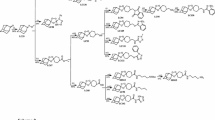Abstract
Kinetic schemes for the intramolecular oxidation of four artemisinin analogs, which are used as drugs against malaria, were developed. Each stage of the kinetic scheme is characterized by the enthalpy, activation energy, and rate constant calculated using the model of intersecting parabolas. The competition of mono- and bimolecular radical reactions was taken into account when developing the schemes. The hydroperoxide groups are formed as a result of the intramolecular oxidation of these compounds and generate free radicals in the reaction with FeII. Among these free radicals, hydroxyl radicals play the key role, since their yield (n OH) correlates with the antimalarial activity of the peroxide compound. The efficiency of the drug (index IC50) exponentially depends on n OH and is expressed by the formula IC50(Artemisinin)/IC50(Compound) = 1.54·10−6exp(3.9n OH). The elementary reactions resulting in the generation of hydroxyl radicals are considered. It is supposed that DNA of a malaria parasite is the main biological target for hydroxyl radicals.
Similar content being viewed by others
References
Y. Li, H. Huang, Y.-L. Wu, in Medicinal Chemistry of Bioactive Natural Products, Eds X.-T. Liang, W.-S. Fang, J. Wiley and Sons, New York, 2006, 183.
E. T. Denisov, S. L. Solodova, T. G. Denisova, Usp. Khim., 2010, 79, 1065 [Russ. Chem. Rev. (Engl. Transl.), 2010, 79, 981].
S. R. Meshnick, T. E. Taylor, S. Kamchonwongpaisan, Microbiol. Rev., 1996, 60, 301.
W. Asawamahasakda, I. Ittarat, Y.-M. Pu, H. Ziffer, S. R. Meshnick, Antimicrob. Agents Chemother., 1994, 38, 1854.
P. M. O’Neill, G. H. Posner, J. Med. Chem., 2004, 47, 2945.
P. A. Berman, P. A. Adams, Free Radical Biol. Med., 1997, 22, 1283.
B. Meunier, A. Robert, Acc. Chem. Res., 2010, 43, 1444.
D. J. Creek, W. N. Charman, F. C. K. Chiu, R. J. Prankerd, K. J. McCullough, Y. Dong, J. L. Vennerstrom, S. A. Charman, J. Pharmaceut. Sci., 2007, 96, 2945.
M. A. Avery, F. Gao, W. K. M. Chong, T. F. Hendrickson, W. D. Inman, P. Crews, Tetrahedron, 1994, 50, 957.
G. H. Posner, D. Wang, J. N. Cumming, C. H. Oh, A. N. French, A. L. Bodley, T. A. Shapiro, J. Med. Chem., 1995, 38, 2273.
E. T. Denisov, T. G. Denisova, F. M. D. Ismail, Int. J. Chem. Kinet., 2005, 37, 554.
S. L. Solodova, E. T. Denisov, Izv. Akad. Nauk, Ser. Khim., 2006, 1502 [Russ. Chem. Bull., Int. Ed., 2006, 55, 1557].
S. L. Solodova, E. T. Denisov, Kinet. Katal., 2007, 48, 220 [Kinet. Catal. (Engl. Transl.), 2007, 48, 204].
S. L. Solodova, E. T. Denisov, T. G. Denisova, Mendeleev Commun., 2008, 18, 24.
S. L. Solodova, E. T. Denisov, Izv. Akad. Nauk, Ser. Khim., 2008, 267 [Russ. Chem. Bull., Int. Ed., 2008, 57, 274].
S. L. Solodova, E. T. Denisov, Izv. Akad. Nauk, Ser. Khim., 2009, 760 [Russ. Chem. Bull., Int. Ed., 2009, 58, 777].
E. T. Denisov, Proc. EUCHEM Conf. on Organic Free Radicals (Bologna, Italy, June 28–July 2, 2010), Bologna, 2010, 53.
E. T. Denisov, T. G. Denisova, Izv. Akad. Nauk, Ser. Khim., 2010, 1831 [Russ. Chem. Bull., Int. Ed., 2010, 59, 1881].
E. T. Denisov, T. G. Denisova, Butlerov. Soobshch. [Butlerov’s Reports], 2010, 23, No. 15, 11 (in Russian).
S. L. Solodova, E. T. Denisov, Sb. tr. IPKhF RAN “Fizika i khimiya protsessov, orientirovannykh na sozdanie novykh naukoemkikh tekhnologii, materialov i oborudovaniya” [Collection of Works of the Institute of Chemical Physics of the Russian Academy of Sciences “Physics and Chemistry of Processes Oriented at the Development of Novel Science Intensive Technologies, Materials, and Equipment], IPKhF, Chernogolovka, 2007, 264 (in Russian).
E. T. Denisov, Org. Biomol. Chem., 2011, 9, 4219.
D. J. Creek, W. N. Charman, F. C. K. Chiu, R. J. Frankerd, Y. Dong, J. L. Vennerstrom, S. A. Charman, Antimicrob. Agents Chemother., 2008, 52, 1291.
E. T. Denisov, Usp. Khim., 1997, 66, 953 [Russ. Chem. Rev. (Engl. Transl.), 1997, 66, 859].
E. T. Denisov, in General Aspects of the Chemistry of Radicals, Ed. Z. B. Alfassi, Wiley, Chichester, 1999, 79.
E. T. Denisov, I. B. Afanasév, Oxidation and Antioxidants in Organic Chemistry and Biology, CRC Press, Taylor and Francis Group, Boca Raton, FL, 2005, 981 pp.
E. T. Denisov, T. G. Denisova, Usp. Khim., 2004, 73, 1181 [Russ. Chem. Rev. (Engl. Transl.), 2004, 73, 1091].
T. G. Denisova, E. T. Denisov, Kinet. Katal., 2006, 47, 124 [Kinet. Catal. (Engl. Transl.), 2006, 47, 121].
E. T. Denisov, C. Chatgilialoglu, A. F. Shestakov, T. G. Denisova, Int. J. Chem. Kinetics, 2009, 41, 284.
E. T. Denisov, T. G. Denisova, T. S. Pokidova, Handbook of Free Radical Initiators, Wiley-Interscience, Hoboken, New Jersey, 2003, 879 pp.
T. G. Denisova, E. T. Denisov, Neftekhimiya, 2004, 44, 278 [Petroleum Chemistry (Engl. Transl.), 2004, 44].
E. T. Denisov, V. E. Tumanov, Usp. Khim., 2005, 74, 905 [Russ. Chem. Rev. (Engl. Transl.), 2005, 74, 825].
Y.-R. Luo, Handbook of Bond Dissociation Energies in Organic Molecules, CRC Press, Boca Raton, 2003, 380 pp.
G. V. Buxton, C. L. Greenstock, W. Ph. Helman, A. B. Ross, J. Phys. Chem. Ref. Data, 1988, 17, 513.
Y.-L. Wu, H.-B. Chen, K. Jiang, Y. Li, F. Shan, D.-Y. Wang, Y.-F. Wang, W.-M. Wu, Y. Wu, Z.-J. Yao, Z.-Y. Yue, C.-M. Zhou, Pure Appl. Chem., 1999, 71, 1139.
W.-M. Wu, Z.-J. Yao, Y.-L. Wu, K. Jiang, Y.-F. Wang, H.-B. Chen, F. Shan, Y. Li, J. Chem. Soc., Chem. Commun., 1996, 18, 2213.
Author information
Authors and Affiliations
Corresponding author
Additional information
Published in Russian in Izvestiya Akademii Nauk. Seriya Khimicheskaya, No. 7, pp. 1398–1412, July, 2011.
Rights and permissions
About this article
Cite this article
Denisov, E.T., Denisova, T.G. Hydroxyl mechanism of the antimalarial effect of artemisinin and its analogs. Russ Chem Bull 60, 1421–1435 (2011). https://doi.org/10.1007/s11172-011-0213-9
Received:
Revised:
Published:
Issue Date:
DOI: https://doi.org/10.1007/s11172-011-0213-9



